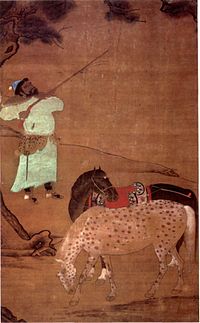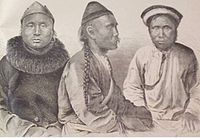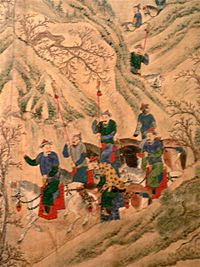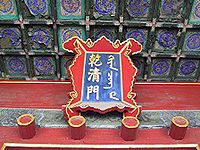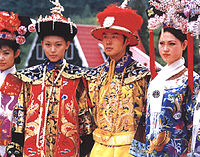- Manchu people
-
"Manchu" redirects here. For other uses, see Manchu (disambiguation).
Manchu (Manju,  )
)
滿族
满族









Nurhaci • Huang Taiji • Dorgon
Kangxi Emperor • Qianlong Emperor • Empress Dowager Cixi
Puyi • Oboi • Heshen
Lao She • John Fugh • Lang LangTotal population approx. 10.68 million (2000)[1] Regions with significant populations Majority populations  People's Republic of China
People's Republic of ChinaMinority populations  North Korea
North Korea Taiwan
Taiwan Russia and Siberia
Russia and Siberia Canada
Canada United States
United States Japan
JapanLanguages Mandarin Chinese,
Manchu (very small population, almost extinct)Religion Historically Shamanism, Heaven worship and Ancestor worship; nowadays Buddhism and Ancestor worship[2][3]
Related ethnic groups Xibe people, other Tungusic peoples
The Manchu people (Manchu:
 Manju; simplified Chinese: 满族; traditional Chinese: 滿族; pinyin: Mǎnzú, Russian: Маньчжуры) are a Tungusic people who originated in Manchuria (today's northeastern China) and one of the 56 ethnic groups of People's Republic of China. During their rise in the 17th century, with the help of the Ming dynasty rebels (such as general Wu Sangui), they came to power in China and founded the Qing Dynasty, which ruled China until the Xinhai Revolution of 1911, which established a republican government in its place.
Manju; simplified Chinese: 满族; traditional Chinese: 滿族; pinyin: Mǎnzú, Russian: Маньчжуры) are a Tungusic people who originated in Manchuria (today's northeastern China) and one of the 56 ethnic groups of People's Republic of China. During their rise in the 17th century, with the help of the Ming dynasty rebels (such as general Wu Sangui), they came to power in China and founded the Qing Dynasty, which ruled China until the Xinhai Revolution of 1911, which established a republican government in its place.For centuries, the Manchu ethnicity has acculturated with the majority Han ethnicity of China. Most Manchu today speak Standard Chinese, while the Manchu language is only spoken by elderly people in remote northeastern China and a few scholars; there are around ten thousand speakers of Xibe, a closely related language spoken in the Ili region of Xinjiang. In recent years, however, there has been a resurgence of interest in Manchu culture among both ethnic Manchus and Han.[4] The number of Chinese today with some Manchu ancestry is quite large—with 10.68 million members (in China), Manchu is the 3rd largest ethnic group in China after the Han and the Zhuang.[5] The adoption of favorable policies towards ethnic minorities (such as preferential university admission, government employment opportunities and exemption from the one child policy) has encouraged some people with mixed Han and Manchu ancestry to re-identify themselves as Manchu.
Contents
- 1 Culture
- 2 History
- 3 Autonomous Areas designated for Manchus
- 4 Notable Manchu
- 5 See also
- 6 Notes
- 7 Sources
- 8 External links
Culture
Aspects of Manchu customs and traditions can be seen in local cuisines, language and customs in Northeast China as well as cities in that region. After the fall of the Ming Dynasty, Manchus also adopted many Han customs and traditions.
They traditionally coiled their hair in high tufts on top of their heads and wore earrings, long gowns and embroidered shoes. The women with higher social standing wore silk and satin clothing while cotton clothing was worn by women of lower social standing. Variants of such costumes (including qi pao and ma gua, Mandarin dress) are still popular all over China. The man's clothing once consisted of a short and adjusted ? jacket over a long gown with a belt at the waist to facilitate horse-riding and hunting.
The traditional Manchu dwellings were made up of three quarters. In the center of the house was the kitchen while the wings contained the dormitory and the living room. The unique Manchu tradition did not allow people to die on nahan (
 ) to the west or north. Believing that doors were made for living souls, the Manchus allowed dead bodies to be taken out only through windows and ground burial was the general practice.[6]
) to the west or north. Believing that doors were made for living souls, the Manchus allowed dead bodies to be taken out only through windows and ground burial was the general practice.[6]The Manchu language is a member of the Tungusic language family.
The Tale of the Nisan Shaman is an important piece of Manchu folklore.[7]
It was reported by American anthropologist Weston La Barre that Manchu mothers used to show affection for their children by performing fellatio on their male babies, placing its penis in their mouths and stimulating it, since it was not considered a sexual act, while the Manchu regarded public kissing with revulsion, which was considered sexual.[8][9][10][11][12][13][14][15][16][17][18][19] They were also reported to caress their children's sexual organs, tickling those of their daughters.[20][21][22]
Manchu girls were reported to be independent and equal to male siblings, having more rights than Chinese girls.[23] Manchu women were said to be aggressive and irritable, Mongol and Chinese Bannermen married to them were reported to be scared of them, complaining to the Emperor, who permitted them to protest out loud to their wives rather than hide.[24][25][26]
During the Qing dynasty, education was discouraged by Manchu women. Many of the princesses could not read the simplest book nor write a letter to a friend, but depended upon educated eunuchs to perform these services for them. The Chinese woman on the contrary could usually read and write with ease, and the education of some of them was equal to that of a Hanlin.[27] However many of these Manchu women of noble background seldom mingle with educated Chinese women even if their husbands were of equal rank in court.
History
Origins and early history
Main article: Jurchen peopleOne of the earliest ancestors of the Manchu can trace back to the ancient Sushen tribes.[28] They were followed by the Yilou people, who were active from AD 202 to 220. The Wuji followed in the 5th century and the tribes of the Mohe in the 6th century. One of the tribes of the Mohe, the Heishui (Amur River) tribe, eventually became the ancestors of the Jurchens, from whom the Manchu originated.[29]
The Jurchens under the Wanyan clan established the Jin Dynasty (literally Golden Dynasty) that ruled the northern half of China (1115–1234) and rivaled the Song Dynasty in southern China. The Jin were conquered by the Mongols under Genghis Khan.
Another theory is that the Manchu people stem their roots from the Merkit people, a native Mongolic tribal people from the Mongolian plateau in the 12th century.
Before the 17th century, the ancestors of the Manchus were generally a pastoral people, hunting, fishing and engaging in limited agriculture and pig-farming.
One of the old traditions of Manchu is the system of bondservants, booi aha or just booi, translated into Mandarin as nucai. The Jurchen tribes employed booi as early as the 15th century, and it was common practice for Manchu military commanders to have their field and house bondservants serving in booi units during military campaigns. The booi differ from Chinese bond slavery in a few key ways, and are somewhat akin to the European feudal liege-bondsman relation. Firstly, booi status is hereditary, similar to a social caste. However, booi were not viewed as properties (although sales of bondservants did occur). Thirdly, booi is more a matter of rank and heredity rather than profession or social status. Indeed, many booi were richly rewarded by their bondmasters, and amassed great wealth and power. Booi status to the imperial Aisin Gioro clan was very prestigious, and they retained the privillege to call themselves "nucai" (slave) when addressing their Aisin Gioro lords. In 1673 the killing of a 'booi's slaves to accompany their dead master to the grave was outlawed.
Founding of the Qing Dynasty
Further information: Qing DynastyIn 1616, Nurhaci broke away from the power of the decaying Ming Dynasty and established the Later Jin Dynasty (後金 Hòu Jīn)/Amaga Aisin Gurun (
 ), domestically called the State of Manchu (manju gurun) (
), domestically called the State of Manchu (manju gurun) ( ), and unified Manchu tribes, establishing (or at least expanding) the Manchu Banner system, a military structure which made their forces quite resilient in the face of superior Ming Dynasty numbers in the field. Nurhaci later conquered Mukden (modern-day Shenyang) and built it into the new capital in 1621.
), and unified Manchu tribes, establishing (or at least expanding) the Manchu Banner system, a military structure which made their forces quite resilient in the face of superior Ming Dynasty numbers in the field. Nurhaci later conquered Mukden (modern-day Shenyang) and built it into the new capital in 1621.In 1636 Nurhaci's son Hong Taiji, reorganized the Manchus, including those other groups (such as Hans and Mongols) who had joined them, changed the nation's name to Qing Empire, and formally changed the name of the ethnic designation to Manchu, outlawing use of the name Jurchen. According to legend, the name was chosen because Hong Taiji's father, Nurhaci, had believed himself to be a reincarnation of the bodhisattva Manjusri. The actual etymology of the name Manchu is debated. The alleged connection to Manjusri faces alternative theories, one of which links the name to the Tungusic word *mangu(n) "river".[citation needed]
When Beijing was captured by Li Zicheng's peasant rebels in 1644, the last Ming Emperor Chongzhen committed suicide. The Manchu then allied with Ming Dynasty general Wu Sangui and seized control of Beijing, which became the new capital of the Qing dynasty. Over the next two decades, the Manchu took command of all of China and defended against Russian hostilities in Russian–Manchu border conflicts.
For political purposes, the early Manchu emperors took wives descended from the Mongol Great Khans, so that their descendants (such as the Kangxi Emperor) would also be seen as legitimate heirs of the Mongol-ruled Yuan dynasty. During the Qing Dynasty, the Manchu government made efforts to preserve Manchu culture and language. These efforts were largely unsuccessful in that Manchus gradually adopted the customs and language of the surrounding Han Chinese and, by the 19th century, spoken Manchu was rarely used even in the Imperial court. Written Manchu, however, was still used for the keeping of records and communication between the emperor and the Banner officials until the collapse of the dynasty. The Qing dynasty also maintained a system of dual appointments in which all major imperial offices would have a Manchu and a Han Chinese member. Because of the small number of Manchus, this insured that a large fraction of them would be government officials.
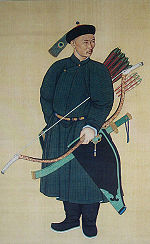 Baturu Zhanyinbao (b. 1760) was one of the Qianlong Emperor's Manchu First Grade Bodyguards
Baturu Zhanyinbao (b. 1760) was one of the Qianlong Emperor's Manchu First Grade Bodyguards
During the Russian Invasion of Northern and Central Manchuria (1900), the Russian Empire annihilated many bannermen as they fought to the death against the Russians, each falling one at a time against a five pronged Russian invasion. The Russians killed many of the Manchus, thousands of them fled south. The Russian Cossacks looted their villages and property and then burnt them to ashes.[30][31]
Near the end of the Qing Dynasty, Manchus were portrayed as outside colonizers by Chinese nationalists such as Sun Yat-Sen, even though the Republican revolution he brought about was supported by many reform-minded Manchu officials and military officers.[32] This portrayal dissipated somewhat after the 1911 revolution as the new Republic of China now sought to include Manchus within its national identity.[33] Until 1924, the government continued to pay stipends to Manchu bannermen; however, many cut their links with their banners and took on Han-style names in shame and to avoid persecution.[34] The official total of Manchu fell by more than half during this period, as they refused to admit to their ethnicity when asked by government officials or other outsiders.[35]
Modern history
Further information: History of ManchuriaIn 1931, the Empire of Japan created a puppet state in Northeast China called Manchukuo. The new state was nominally ruled by Emperor Puyi. By this time the population of historical Manchuria was overwhelmingly Han Chinese, so while Manchukuo was intended to be a state for Manchus (though many were murdered by the Japanese), Manchukuo had a majority Han population. Manchukuo was abolished at the end of World War II, with its territory incorporated back into China.
The People's Republic of China recognised the Manchu as one of the country's official minorities in 1952.[36] In the 1953 census, 2.5 million people identified themselves as Manchu.[37] The Communist government also attempted to improve the treatment of Manchu people; some Manchu people who had hidden their ancestry during the period of KMT rule thus became more comfortable to reveal their ancestry, such as the writer Lao She, who began to include Manchu characters in his fictional works in the 1950s (in contrast to his earlier works which had none).[38] Between 1982 and 1990, the official count of Manchu people more than doubled from 4,299,159 to 9,821,180, making them China's fastest-growing ethnic minority.[39] In fact, however, this growth was not due to natural increase, but instead people formerly registered as Han applying for official reclassification as Manchu.[40]
Autonomous Areas designated for Manchus
Province or equivalent prefecture-level city Name Traditional Chinese Simplified Chinese pinyin Designated minority Local name Capital Hebei Chengde Fengning Manchu Autonomous County 豊寧滿族自治縣 丰宁满族自治县 Fēngníng Mǎnzú Zìzhìxiàn Manchu Fengning Manju Zijysiyan Daming Kuancheng Manchu Autonomous County 寛城滿族自治縣 宽城满族自治县 Kuānchéng Mǎnzú Zìzhìxiàn Kuwanceng Manju Zijysiyan Kuancheng Weichang Manchu and Mongol Autonomous County 圍場滿族蒙古族自治縣 围场满族蒙古族自治县 Wéichǎng Mǎnzú Měnggǔzú Zìzhìxiàn Manchu and Mongol ? Waichang Town Qinhuangdao Qinglong Manchu Autonomous County 青龍滿族自治縣 青龙满族自治县 Qīnglóng Mǎnzú Zìzhìxiàn Manchu Cinglung Manju Zijysiyan Qinglong Jilin Siping Yitong Manchu Autonomous County 伊通滿族自治縣 伊通满族自治县 Yītōng Mǎnzú Zìzhìxiàn Itung Manju Zijysiyan Yitong Town Liaoning Fushun Xinbin Manchu Autonomous County 新賓滿族自治縣 新宾满族自治县 Xīnbīn Mǎnzú Zìzhìxiàn Sinbin Manju Zijysiyan Xinbin Town Qingyuan Manchu Autonomous County 清原滿族自治縣 清原满族自治县 Qīngyuán Mǎnzú Zìzhìxiàn Cingyuwan Manju Zijysiyan Qingyuan Town Benxi Benxi Manchu Autonomous County 本溪滿族自治縣 本溪满族自治县 Běnxī Mǎnzú Zìzhìxiàn Xiaoshi Town Huanren Manchu Autonomous County 桓仁滿族自治縣 桓仁满族自治县 Huánrén Mǎnzú Zìzhìxiàn Huwanren Manju Zijysiyan Huanren Town Anshan Xiuyan Manchu Autonomous County 岫岩滿族自治縣 岫岩满族自治县 Xiùyán Mǎnzú Zìzhìxiàn ? Xiuyan Town Dandong Kuandian Manchu Autonomous County 寛甸滿族自治縣 宽甸满族自治县 Kuāndiàn Mǎnzú Zìzhìxiàn Kuwandiyan Manju Zijysiyan Kuandian Town Notable Manchu
Pre-Qing Dynasty era
- Nurhaci (努爾哈赤) - founder of the Later Jin and the Qing Dynasty.
Qing Dynasty era
Emperors
The Qing Dynasty was the last of the Chinese dynasties. All the emperors of the Qing Dynasty were Manchu. They are in order
- Hong Taiji (皇太極)
- Shunzhi Emperor (順治皇帝)
- Kangxi Emperor (康熙皇帝)
- Yongzheng Emperor (雍正皇帝)
- Qianlong Emperor (乾隆皇帝)
- Jiaqing Emperor (嘉慶皇帝)
- Daoguang Emperor (道光皇帝)
- Xianfeng Emperor (咸豐皇帝)
- Tongzhi Emperor (同治皇帝)
- Guangxu Emperor (光緒皇帝)
- Xuantong Emperor (宣統皇帝)
Nobility and aristocrats
As the Qing Dynasty had Manchu Emperors, many other prominent positions in government were also held by Manchu people.
Aisin Gioro Clan (愛新覺羅氏)
Aisin Gioro is the family name of the Qing Dynasty Emperors. The Emperor's relatives were involved in government. Notable people from this family include:
- Dorgon (多爾袞) - a son of Nurhaci. Served as Regent during the early Qing Dynasty.
- Dodo (多鐸) - a son of Nurhaci. Titled Prince Yu (豫親王), and a military commander.
- Yixin (奕訢) - a son of the Daoguang Emperor. Titled Prince Gong (恭親王). He spearheaded the Self-Strengthening Movement (自強運動).
- Yoshiko Kawashima (川島芳子) - served as a spy for the Japanese Imperial Army during the Sino-Japanese War.
Miscellanea
Aside from the imperial family, other government posts during the Qing Dynasty were given to Manchu people:
- Empress Dowager Cixi (慈禧太后) - from the Yehe Nara Clan. She wielded the actual power of the Qing Dynasty in its final years.
- Oboi (鰲拜) - a Baturu from the Guwalgiya Clan. One of the Four Regents during the Kangxi Emperor's early reign.
- Sonin (索尼) - from the Heseri Clan. One of the Four Regents during the Kangxi Emperor's early reign.
- Songgotu (索額圖) - son of Sonin. He represented Qing China in the Treaty of Nerchinsk.
- Suksaha (蘇克薩哈) - from the Nara Clan. One of the Four Regents during Kangxi Emperor's early reign.
- Mingzhu (明珠) - an important official during the Kangxi Emperor's reign.
- Nalan Xingde (纳兰性德) - son of Nalan Mingzhu. poet.
- Fu Kang'an (福康安) - an important military commander during the Qianlong Emperor's reign.
- Heshen (和珅) - from the Niohuru Clan. An important official during the Qianlong Emperor's reign.
- Changlin (長麟) - from the Gioro Clan. An important official during the reigns of the Qianlong and Jiaqing Emperors.
Military officers in the Sino-Japanese War
- Deng Tiemei (鄧鐵梅)[citation needed]
- Zhao Shangzhi (趙尚志)[citation needed]
- Tong Linge (佟麟閣)[citation needed]
- Guan Xiangying (關向應)[citation needed]
Politicians
- Pujie (溥傑) - younger brother of Puyi, served as a politician.
- John Kuan (關中) - vice-chairman of the Chinese Nationalist Party.
- Liu Lanbo (刘澜波) - former Minister of Water Resources of the People's Republic of China.
Athletes
- Wu Ch'uan-yu (吳全佑) - founder of Wu style tai chi chuan.
- Wu Chien-ch'uan (吳鑑泉) - son of Wu Ch'uan-yu.
- Wu Jing (吳京) - martial artist and film actor.
- Zhao Junzhe (肇俊哲) - a professional Chinese football player currently playing for Liaoning FC. He represented the Chinese football team and appeared in the 2002 FIFA World Cup.[41]
- Lang Ping (郎平) - former head coach of the U.S. women's national volleyball team.
Writers and poets
- Lao She (老舍) - one of the most significant figures of 20th century Chinese literature, and is perhaps best known for his novel Rickshaw Boy and the play Teahouse (茶館).
- Wang Shuo (王朔) - a Chinese author, director, actor, and cultural icon. He has written over 20 novels, television series and movies.
Artists
- Pu Ru (溥儒) - cousin of the last emperor, Puyi. He was a notable painter and professor at the Fine Arts Department of the National Taiwan Normal University.
- Qigong (启功) - calligrapher and art historian for the Imperial Palace Museum in Beijing.
Musicians
- Lang Lang (郎朗) - a Chinese concert pianist, currently residing in New York. He is well known in Europe and North America for his concert appearances.
- Wang Liping (王立平) - composer.
- Na Ying (那英) - singer and pop star. She is considered as one of the best present-day female singers in Mainland China, having sold more than 10 million albums. She is also noted for her buoyant and forthright personality.[42]
- Ai Jing[43] (艾敬) - singer and painter. China's Northeast News called her "China's most talented female folk rock singer."[44]
Media and entertainment industry
- Cheng Yanqiu (程砚秋) - a dramatist, he was one of the great twentieth century performers of the Dan role type in Peking Opera.
- Tong Dawei (佟大为) -an actor from mainland China. He is best known for starring in films such as Lost in Beijing and I Love You.
- Hu Jun (胡軍) - an actor from mainland China. He is known for his dramatic roles in various films (both Mainland Chinese and Hong Kong) and TV series.
- Sihung Lung (郎雄) - A Taiwanese actor who appeared in over 100 films and was best known for playing paternal roles in films including Eat Drink Man Woman and The Wedding Banquet. He frequently collaborated with award-winning director Ang Lee, notably cast in films such as Crouching Tiger, Hidden Dragon and Pushing Hands.
- Chyi Chin (齊秦) - Taiwanese singer, younger brother of Chyi Yu.
- Chyi Yu (齐豫) - Taiwanese singer, elder sister of Chyi Chin and is best known for her 1979 hit, "The Olive Tree" (橄欖樹).
- Kara Hui (惠英紅) - a Hong Kong actress.
- Rosamund Kwan (關之琳) - Hong Kong actress, half Manchu by descent. She is best known internationally for her roles in Hong Kong action films, alongside a variety of major stars of the genre.
- Kathy Chow Hoi-Mei (周海媚) - Hong Kong actress and model, half Manchu by descent.
- Jenny Pat - granddaughter of Fu Baoshi, half Manchu by descent. She is a television presenter and Canadian actress affiliated with Fairchild TV.
See also
- Jurchen people
- Manchuria
- Jin Dynasty
- Qing Dynasty
- Nurhaci
- List of Manchu clans
- Manchukuo
- Anti-Manchuism
- Manchu people in Taiwan
Notes
- ^ "Ethnic Groups - china.org.cn - The Manchu ethnic minority". http://www.china.org.cn/e-groups/shaoshu/shao-manchu.htm. Retrieved 2008-09-26.
- ^ Sate Nationalities Affairs Commission (September 2005). Zhang Yongfa and Fang Yongming. ed. Selected pictures of Chinese ethnic groups (First ed.). China Pictorial Publishing House. pp. 48. ISBN 7-80024-956-5.
- ^ Wang Can; Wang Pingxing (May 2004). Ethnic groups in China. China Intercontinental Press. ISBN 7-5085-0490-9.
- ^ "Eras Journal - Tighe, J: Review of "The Manchus", Pamela Kyle Crossley". http://arts.monash.edu.au/publications/eras/edition-5/tighe.php. Retrieved 2011-04-27.
- ^ Wang & Wang 2005, pp. 9, 109
- ^ The interweaving of rituals: funerals in the cultural exchange between China. "". http://books.google.co.uk/books?id=RrMwaWmYHPgC&lpg=PA24&dq=funeral%20traditions%20window%20doors&pg=PA24#v=onepage&q=window&f=false. Retrieved 29 April 2011.
- ^ Durrant, Stephen W. (Winter 1979). "The Nišan Shaman Caught in Cultural Contradiction". Signs (The University of Chicago Press) 5 (2): 338–347. doi:10.1086/493712. http://www.jstor.org/stable/3173565.
- ^ Weston La Barre (1975). Anthropological perspectives of movement, Volume 1. Ayer Publishing. p. 57. ISBN 040506201X. http://books.google.com/books?id=bI6WIh8-qjIC&pg=PA57&dq=manchu+mothers+have+the+pattern+of+penis+baby+boy+mouths&hl=en&ei=QuqtTb_wF4bpgQfl3fSEDA&sa=X&oi=book_result&ct=result&resnum=2&ved=0CDcQ6AEwAQ#v=onepage&q=manchu%20mothers%20have%20the%20pattern%20of%20penis%20baby%20boy%20mouths&f=false. Retrieved 19 April 2011.
- ^ Weston La Barre (1947). The Cultural Basis of Emotions and Gestures. Ardent Media. p. 57. http://books.google.com/books?id=oL595B-c3ZcC&pg=PA57&dq=manchu+mothers+have+the+pattern+of+penis+baby+boy+mouths&hl=en&ei=QuqtTb_wF4bpgQfl3fSEDA&sa=X&oi=book_result&ct=result&resnum=1&ved=0CDIQ6AEwAA#v=onepage&q=manchu%20mothers%20have%20the%20pattern%20of%20penis%20baby%20boy%20mouths&f=false. Retrieved 19 April 2011.
- ^ Christian Laes (2011). Children in the Roman Empire: Outsiders Within. Cambridge University Press. p. 262. ISBN 0521897467. http://books.google.com/books?id=yxo5kMPLoagC&pg=PA262&dq=manchu+mother+son's+penis&hl=en&ei=mRypTe_LDsnegQeAqcDzBQ&sa=X&oi=book_result&ct=result&resnum=8&ved=0CEoQ6AEwBzgo#v=onepage&q=manchu%20mother%20son's%20penis.&f=false. Retrieved 19 April 2011.
- ^ Weston La Barre (1980). Culture in context: selected writings of Weston La Barre. Duke University Press. p. 266. http://books.google.com/books?ei=YBypTaWZD4jDgQfM_rnzBQ&ct=result&id=KxOBAAAAMAAJ&dq=Even+more+striking%2C+from+our+point+of+view%2C+is+that+among+the+same+Manchu+who+regard+public+kissing+with+such+horror%2C+it+is+quite+customary+for+a+mother+to+take+the+penis+of+her+small+son+into+her+mouth+and+to+tickle+the+genitals+of+her&q=mouth+penis+son. Retrieved 19 April 2011.
- ^ Duke University. School of Law (1955). Obscenity and the arts. School of Law, Duke University. p. 542. http://books.google.com/books?ei=Wh-pTc6YJMHYgAfBiOnzBQ&ct=result&id=HGJZAAAAIAAJ&dq=Even+more+striking%2C+from+our+point+of+view%2C+is+that+among+the+same+Manchu+who+regard+public+kissing+with+such+horror%2C+it+is+quite+customary+for+a+mother+to+take+the+penis+of+her+small+son+into+her+mouth+and+to+tickle+the+genitals+of+her&q=son+mouth+penis. Retrieved 19 April 2011.
- ^ Alison Dundes Renteln (2005). The Cultural Defense. Oxford University Press US. p. 243. ISBN 0195154037. http://books.google.com/books?id=zyWr3dSXUrIC&pg=PA243&dq=Even+more+striking,+from+our+point+of+view,+is+that+among+the+same+Manchu+who+regard+public+kissing+with+such+horror,+it+is+quite+customary+for+a+mother+to+take+the+penis+of+her+small+son+into+her+mouth+and+to+tickle+the+genitals+of+her&hl=en&ei=ZB-pTZD3OsGugQeW3ZH0BQ&sa=X&oi=book_result&ct=result&resnum=1&ved=0CCgQ6AEwAA#v=onepage&q=Even%20more%20striking%2C%20from%20our%20point%20of%20view%2C%20is%20that%20among%20the%20same%20Manchu%20who%20regard%20public%20kissing%20with%20such%20horror%2C%20it%20is%20quite%20customary%20for%20a%20mother%20to%20take%20the%20penis%20of%20her%20small%20son%20into%20her%20mouth%20and%20to%20tickle%20the%20genitals%20of%20her&f=false. Retrieved 19 April 2011.
- ^ Phyllis Kronhausen, Eberhard Kronhausen (1964). The sexually responsive woman. Grove Press. p. 109. http://books.google.com/books?ei=gBypTbGPGcOtgQf-l_HzBQ&ct=result&id=VHhFAAAAMAAJ&dq=one+such+exception+to+the+general+rule+being+the+Manchu+society.+In+that+central+Asian+group+of+people%2C+anthropologist+Weston+La+Barre+reports%2C+%22it+is+quite+customary+for+a+mother+to+take+the+penis+of+her+small+son+into+her+mouth&q=penis+son+mouth. Retrieved 19 April 2011.
- ^ Michael Grant, Rachel Kitzinger (1988). Civilization of the ancient Mediterranean: Greece and Rome, Volume 2. Scribner's. p. 1251. ISBN 0684188651. http://books.google.com/books?id=j4_pAAAAMAAJ&q=manchu+mother+son's+penis&dq=manchu+mother+son's+penis&hl=en&ei=xRypTddMzJ2BB-jv2fMF&sa=X&oi=book_result&ct=result&resnum=2&ved=0CDIQ6AEwAQ. Retrieved 19 April 2011.
- ^ Neal H. Walls (2001). Desire, discord, and death: approaches to ancient Near Eastern myth. American Schools of Oriental Research. p. 81. ISBN 0897570561. http://books.google.com/books?id=3mrXAAAAMAAJ&q=manchu+mother+son's+penis&dq=manchu+mother+son's+penis&hl=en&ei=2B-pTfBGiMSAB4zoyPMF&sa=X&oi=book_result&ct=result&resnum=3&ved=0CDcQ6AEwAg. Retrieved 19 April 2011.
- ^ David L. Balch, Carolyn Osiek (2003). Early Christian families in context: an interdisciplinary dialogue. Wm. B. Eerdmans Publishing. p. 320. ISBN 080283986X. http://books.google.com/books?id=VjMdbpzLhRQC&pg=PA320&dq=manchu+mother+son's+penis&hl=en&ei=8x-pTdf7J8HOgAfizN3zBQ&sa=X&oi=book_result&ct=result&resnum=5&ved=0CEAQ6AEwBA#v=onepage&q=manchu%20mother%20son's%20penis&f=false. Retrieved 19 April 2011.
- ^ David M. Halperin, John J. Winkler (1990). Before sexuality: the construction of erotic experience in the ancient Greek world. Princeton University Press. p. 3. ISBN 0691002215. http://books.google.com/books?id=_6qLgVl4uikC&pg=PA3&dq=manchu+mother+son's+penis&hl=en&ei=FyCpTeybIcSRgQfDkfWHAQ&sa=X&oi=book_result&ct=result&resnum=1&ved=0CC4Q6AEwAA#v=onepage&q=manchu%20mother%20son's%20penis&f=false. Retrieved 19 April 2011.
- ^ John R. Clarke (2001). Looking at lovemaking: constructions of sexuality in Roman art, 100 B.C.-A.D. 250, Part 250. University of California Press. p. 15. ISBN 0520229045. http://books.google.com/books?id=bwNdgd8cQcgC&pg=PA15&dq=manchu+mother+son's+penis&hl=en&ei=2B-pTfBGiMSAB4zoyPMF&sa=X&oi=book_result&ct=result&resnum=4&ved=0CDsQ6AEwAw#v=onepage&q=manchu%20mother%20son's%20penis&f=false. Retrieved 19 April 2011.
- ^ Bancroft-Whitney Company, Lawyers Co-operative Publishing Company (1967). American jurisprudence proof of facts, annotated: a carefully edited compilation of trial guide material in text and in question and answer form designed to assist lawyers in preparing for trial and in examining witnesses, Volume 18. Bancroft-Whitney Co. [and] Lawyers Co-operative Pub. Co., Rochester, N.Y.. p. 478. http://books.google.com/books?id=tMQgAAAAIAAJ&q=the+Manchus,+where+it+is+considered+shocking+in+the+extreme+for+a+man+and+woman+to+be+seen+kissing+in+public.+Yet+the+Manchu+mother+may+engage+in+utterly+uninhibited+fondling+of+the+genitals+of+her+son+or+daughter+while+petting+them&dq=the+Manchus,+where+it+is+considered+shocking+in+the+extreme+for+a+man+and+woman+to+be+seen+kissing+in+public.+Yet+the+Manchu+mother+may+engage+in+utterly+uninhibited+fondling+of+the+genitals+of+her+son+or+daughter+while+petting+them&hl=en&ei=ShypTbK8NcbGgAfl3IH0BQ&sa=X&oi=book_result&ct=result&resnum=1&ved=0CCgQ6AEwAA. Retrieved 19 April 2011.
- ^ Gwen J. Broude (1994). Marriage, family, and relationships: a cross-cultural encyclopedia. ABC-CLIO. ISBN 0874367360. http://books.google.com/books?id=lgdHAAAAMAAJ&q=manchu+mothers+tickle+the+genitals+of+their+little+daughters+and+suck+the+penis+of+a+small+son&dq=manchu+mothers+tickle+the+genitals+of+their+little+daughters+and+suck+the+penis+of+a+small+son&hl=en&ei=ox-pTcHHA4fagAfExIH0BQ&sa=X&oi=book_result&ct=result&resnum=1&ved=0CCgQ6AEwAA. Retrieved 19 April 2011.
- ^ The Journal of psychohistory, Volume 26. Atcom. 1998. http://books.google.com/books?id=dt0nAAAAYAAJ&q=manchu+mothers+tickle+the+genitals+of+their+little+daughters+and+suck+the+penis+of+a+small+son&dq=manchu+mothers+tickle+the+genitals+of+their+little+daughters+and+suck+the+penis+of+a+small+son&hl=en&ei=ox-pTcHHA4fagAfExIH0BQ&sa=X&oi=book_result&ct=result&resnum=2&ved=0CCwQ6AEwAQ. Retrieved 19 April 2011.
- ^ Katharine Augusta Carl (1906). With the Empress Dowager of China. E. Nash. p. 221. http://books.google.com/books?id=a0UNAAAAYAAJ&pg=PA221&dq=manchu+girl+chinese&hl=en&ei=MCGpTeuFMZT2gAeeuIT0BQ&sa=X&oi=book_result&ct=result&resnum=4&ved=0CD8Q6AEwAw#v=onepage&q=manchu%20girl%20chinese&f=false. Retrieved 19 April 2011.
- ^ Transactions, American Philosophical Society (vol. 36, Part 1, 1946). American Philosophical Society. 1946. p. 12. ISBN 1422377199. http://books.google.com/books?id=g08LAAAAIAAJ&pg=PA12&dq=When+a+Chinese+official+was+the+victim+of+his+ill-+tempered+Manchu+wife,+the+court+held+her+parents&hl=en&ei=niKpTcqdCILKgQe19oT0BQ&sa=X&oi=book_result&ct=result&resnum=1&ved=0CCgQ6AEwAA#v=onepage&q=When%20a%20Chinese%20official%20was%20the%20victim%20of%20his%20ill-%20tempered%20Manchu%20wife%2C%20the%20court%20held%20her%20parents&f=false. Retrieved 19 April 2011.
- ^ Karl August Wittfogel, Jiasheng Feng (1949). History of Chinese society: Liao, 907-1125, Volume 36. American Philosophical Society: distributed by the Macmillan Co., New York. p. 12. http://books.google.com/books?ei=3yKpTdCuI9HogQei05n0BQ&ct=result&id=bisWAAAAIAAJ&dq=When+a+Chinese+official+was+the+victim+of+his+ill-+tempered+Manchu+wife%2C+the+court+held+her+parents&q=ill+tempered. Retrieved 19 April 2011.
- ^ History Society (University of Hong Kong (1961). Annual. History Society, University of Hong Kong.. p. 20. http://books.google.com/books?ei=mSGpTaWgCYXegQfi89jzBQ&ct=result&id=bjPTAAAAMAAJ&dq=So+frightened+were+the+Mongols+and+Chinese+Bannermen+of+their+Manchu+wives+that+the+emperor+permitted+them+to+complain+openly+of+their+great+misfortune%2C+and+sometimes+to+hold+the+parents+of+the+ill-tempered+Manchu+girl+responsible&q=frightened. Retrieved 19 April 2011.
- ^ Bay View Reading Club (1910). Bay View magazine, Volume 18. J. M. Hall. p. 289. http://books.google.com/books?id=pbSgAAAAMAAJ&pg=PA289&dq=education+was+discouraged+by+the+manchu+lady+princesses+could+not+read+the+chinese+lady+can+read+and+write&hl=en&ei=zOwdTu2EKqni0QG21837Bw&sa=X&oi=book_result&ct=result&resnum=2&ved=0CC4Q6AEwAQ#v=onepage&q=education%20was%20discouraged%20by%20the%20manchu%20lady%20princesses%20could%20not%20read%20the%20chinese%20lady%20can%20read%20and%20write&f=false. Retrieved 19 April 2011.
- ^ Association for Asian Studies (1987). The Journal of Asian studies, Volume 46, Issues 3-4. Cambridge University Press on behalf of the Association for Asian Studies. p. 767.
- ^ Huang, P.: "New Light on the origins of the Manchu," Harvard Journal of Asiatic Studies, vol. 50, no.1 (1990): 239-82. Retrieved from JSTOR database July 18, 2006.
- ^ Sergeĭ Mikhaĭlovich Shirokogorov (1924). Social organization of the Manchus: A study of the Manchu clan organization. Royal Asiatic Society. p. 4. http://books.google.com/books?ei=1AfnTd2pEYPQgAfD_KXyCg&ct=result&id=ZERxAAAAMAAJ&dq=In+1900+during+the+Boxer+movement+the+Manchu+population+of+the+Aigun+district+sustained+great+losses%2C+%E2%80%94+thousands+of+refugees%2C+in+fact+all+the+present+population%2C+left+their+homes+and+started+to+the+south.+Months+later+they+came+back&q=ashes+homes+cossacks+burnt. Retrieved 2011-06-01.
- ^ Edward J. M. Rhoads (2001). Manchus & Han: Ethnic Relations and Political Power in Late Qing and Early Republican China, 1861-1928. University of Washington Press. p. 72. ISBN 0295980400. http://books.google.com/books?id=QiM2pF5PDR8C&printsec=frontcover&dq=manchu+han&hl=en&ei=oOmsTJi3G8T_lgeAroHdCA&sa=X&oi=book_result&ct=result&resnum=1&ved=0CCgQ6AEwAA#v=onepage&q=manchus%20took%20part%20metropolitan%20banners%20peking%20field%20force%20tiger%20spirit%20division%20center%20division&f=false. Retrieved 2010-06-28.
- ^ Rhoads 2000, p. 265
- ^ Rhoads 2000, p. 275
- ^ Rhoads 2000, p. 270
- ^ Rhoads 2000, pp. 270, 283
- ^ Rhoads 2000, p. 277
- ^ Rhoads 2000, p. 276
- ^ Rhoads 2000, p. 280
- ^ Rhoads 2000, p. 282
- ^ Rhoads 2000, p. 283
- ^ "Members on the Chinese national football team - players Zhao Junzhe". Sohu.com Inc.. 2007-09-27. http://teamchina.sports.sohu.com/20070928/n252416843.shtml. Retrieved 2011-02-20.
- ^ Mandopop diva returns, Global Times, December 25, 2009 (china.org.cn)
- ^ ""流浪的燕子"回家了 ("Wandering Swallow" Ai Jing has come home)". 东北新闻网 (Northeast News Online). 27 September 2003. http://amuse.nen.com.cn/73746443898191872/20030927/1227501.shtml. Retrieved 4 November 2010.
- ^ ""流浪的燕子"回家了 ("Wandering Swallow" Ai Jing has come home)". 东北新闻网 (Northeast News Online). 27 September 2003. http://amuse.nen.com.cn/73746443898191872/20030927/1227501.shtml. Retrieved 16 October 2009. ""中国最具才华的民谣女诗人"
"民谣" literally translates to "folk rock" or "folk ballad" and refers to a style of music (more completely called 城市民谣, "urban folk rock") that started in the 1990s."
 This article incorporates text from Court life in China: the capital, its officials and people, by Isaac Taylor Headland, a publication from 1909 now in the public domain in the United States.
This article incorporates text from Court life in China: the capital, its officials and people, by Isaac Taylor Headland, a publication from 1909 now in the public domain in the United States. This article incorporates text from Bay View magazine, Volume 18, by Bay View Reading Club, a publication from 1910 now in the public domain in the United States.
This article incorporates text from Bay View magazine, Volume 18, by Bay View Reading Club, a publication from 1910 now in the public domain in the United States.
Sources
- Rhoads, Edward J. M. (2000). Manchus & Han: Ethnic Relations and Political Power in Late Qing and Early Republican China, 1861-1928. University of Washington Press. ISBN 0295980400. http://books.google.com/?id=QiM2pF5PDR8C.
- Wang, Can; Wang, Pingxing (May 2005). Ethnic Groups in China. China Intercontinental Press. ISBN 7-5085-0490-9.
External links
Chinese
East South Central Southwest North Northeast Northwest Nationwide Categories:- Tungusic peoples
- Manchuria
- Manchu people
Wikimedia Foundation. 2010.



